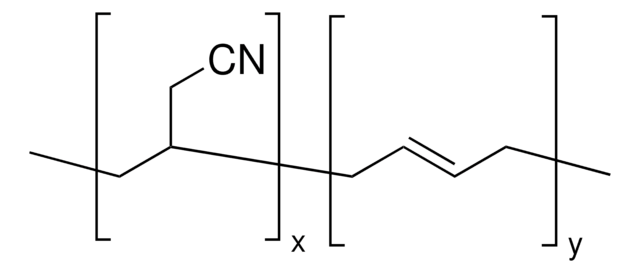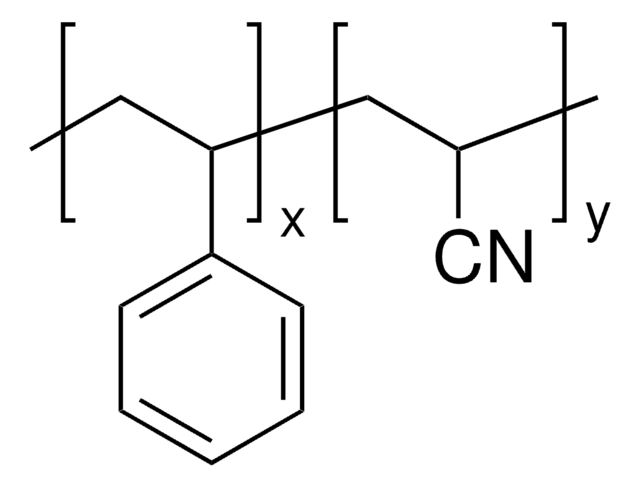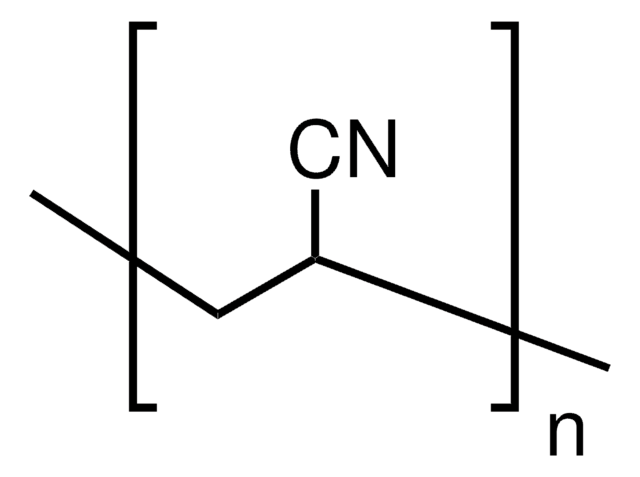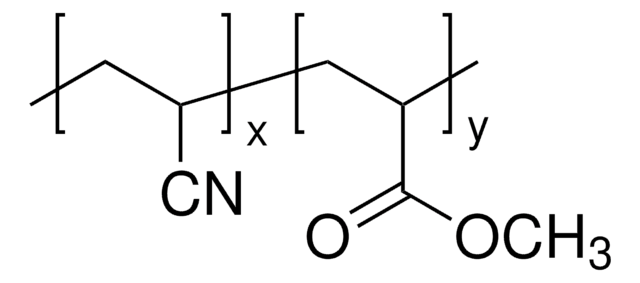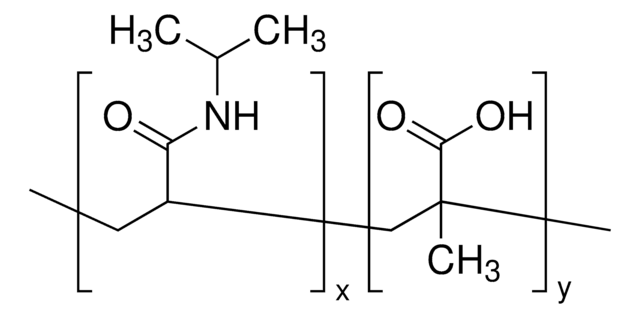182869
Poly(styrene-co-acrylonitrile)
average Mw ~185,000 by GPC, acrylonitrile 30 wt. %, powder
Autenticatiper visualizzare i prezzi riservati alla tua organizzazione & contrattuali
About This Item
Formula condensata:
[CH2CH(C6H5)]x[CH2CH(CN)]y
Numero CAS:
Numero MDL:
Codice UNSPSC:
12162002
ID PubChem:
NACRES:
NA.23
Prodotti consigliati
Forma fisica
powder
PM
average Mw ~185,000 by GPC
Composizione
acrylonitrile, 30 wt. %
Densità
1.08 g/mL at 25 °C (lit.)
Stringa SMILE
C=CC#N.C=Cc1ccccc1
InChI
1S/C8H8.C3H3N/c1-2-8-6-4-3-5-7-8;1-2-3-4/h2-7H,1H2;2H,1H2
SCUZVMOVTVSBLE-UHFFFAOYSA-N
Cerchi prodotti simili? Visita Guida al confronto tra prodotti
Applicazioni
- Acrylonitrile-styrene-acrylate particles with different microstructure for improving the toughness of poly (styrene-co-acrylonitrile) resin: Examines the enhancement of SAN resin toughness using ASA particles with various morphologies, potentially useful for developing advanced polymeric materials (Y Zhang et al., 2021).
- Fabrication by spin-coating and optical characterization of poly (styrene-co-acrylonitrile) thin films: Describes the fabrication and optical properties assessment of PSAN thin films, useful in materials science for applications requiring detailed optical properties analysis (E Hedl et al., 2021).
- Rapid fabrication of periodic patterns on poly (styrene-co-acrylonitrile) surfaces using direct laser interference patterning: Discusses a method for patterning PSAN surfaces, relevant for materials science research involving microfabrication and nanotechnology (MF Broglia et al., 2015).
- A novel solid-solid phase change material based on poly (styrene-co-acrylonitrile) grafting with palmitic acid copolymers: Investigates PSAN-based solid-solid phase change materials, which could be significant in drug delivery systems where temperature control is crucial (S Mu et al., 2015).
- Synthesis, optimization, and characterization of poly (Styrene‐co‐Acrylonitrile) copolymer prepared via precipitation polymerization: Provides insights into the synthesis and properties of PSAN copolymers, applicable in designing materials with specific mechanical and thermal characteristics (MR El‐Aassar et al., 2018).
Codice della classe di stoccaggio
11 - Combustible Solids
Classe di pericolosità dell'acqua (WGK)
WGK 3
Dispositivi di protezione individuale
dust mask type N95 (US), Eyeshields, Gloves
Scegli una delle versioni più recenti:
Possiedi già questo prodotto?
I documenti relativi ai prodotti acquistati recentemente sono disponibili nell’Archivio dei documenti.
I clienti hanno visto anche
[Hygienic chemical studies on plastics (II). Residual acrylonitrile in ABS resin or AS resin and its migration into water (author's transl)].
T Tatsuno et al.
Eisei Shikenjo hokoku. Bulletin of National Institute of Hygienic Sciences, (97)(97), 93-97 (1979-01-01)
Il team dei nostri ricercatori vanta grande esperienza in tutte le aree della ricerca quali Life Science, scienza dei materiali, sintesi chimica, cromatografia, discipline analitiche, ecc..
Contatta l'Assistenza Tecnica.